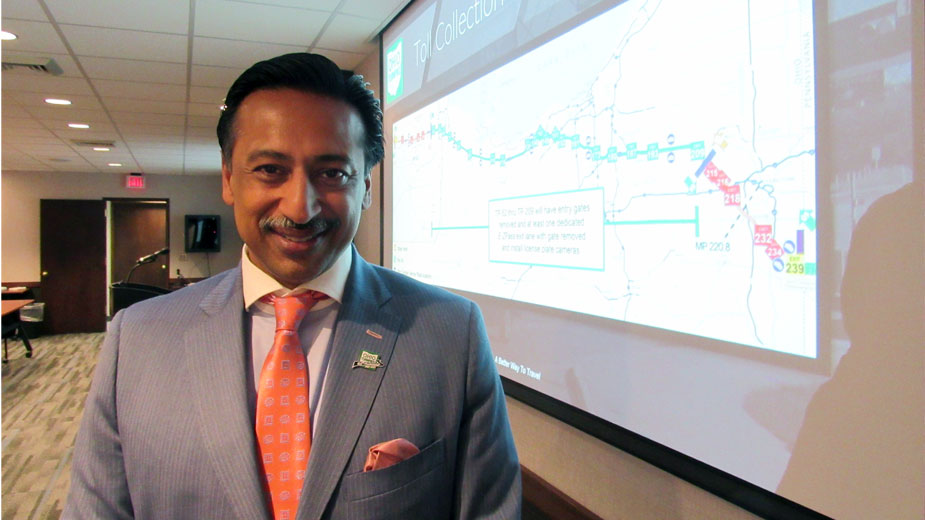Ohio Turnpike to Modernize By 2022
YOUNGSTOWN, Ohio — Over the next two years, the Ohio Turnpike plans to spend more than $200 million to convert its toll locations to electronic gates and eliminate nine stations at less-traveled interchanges – four of which serve the Mahoning Valley.
“When you move into electronic tolling, the low-volume gates are just eliminated,” said Ferzan Ahmed, executive director of the Ohio Turnpike and Infrastructure Commission. “The access is not eliminated, the exit is still there.”
The plan, Ahmed said, is to remove toll charges and booths on the first four of the eastern exits and five of the last western exits along the turnpike. He said it costs more to operate those nine toll locations than they earn in revenue.
“These nine gates at either end of the turnpike only give us revenue of $750,000 a year,” Ahmed said. “It costs more than that to maintain those gates.”
Locally, those toll gates slated for removal are exits 232 to Youngstown, 218 to Niles-Youngstown, 216 to Lordstown and 209 to Warren.
Ahmed was the featured speaker Monday at the Youngstown/Warren Regional Chamber’s Lattes & Legislators program, held at the Eastgate Regional Council of Governments‘ offices downtown.
The new system would eliminate gates along the turnpike and instead use electronic sensors to record vehicles as they pass through, Ahmed said. Those with an E-Z Pass will be charged to their account while others would receive a bill through the mail. However, the turnpike commission would need legislation passed through the General Assembly that would allow the commission to bill motorists and place a hold on their driver’s licenses and registration for nonpayment.
The modernization effort – scheduled for completion by 2022 – would also lead to the elimination of some jobs, particularly toll collectors, Ahmed said. Just how many jobs remains to be seen, but he noted that these employees could be trained for other positions.
John Zehentbauer, superintendent of Mahoning County Career & Technical Center, said that he believes trade schools across Ohio could help.
“I think the career centers are well suited,” he said. “We could set up a program in a quick period of time and there’s not a lot of bureaucracy. We do a lot of that now, where people customize training.”
Ahmed also provided a vision of the turnpike that fully embraces what he called the “next revolution in transportation.”
“It’s going to require an immense amount of change in people’s thinking,” Ahmed said.
At the forefront of this revolution is driverless and electric vehicle technology, he said, and the turnpike wants to adapt for these fast-paced changes.
He said the commission is in discussions about how to prepare for self-driving vehicles as it relates to signage and electronic signals, such as dedicated short-range communications platforms.
This network would use RSUs, or roadside units, along the turnpike that connect with onboard units installed on self-driving vehicles. The turnpike is partnering with Drive Ohio, an organization that is working with public infrastructure agencies to develop a network to support automated transportation.
So far, the commission has installed 15 roadside units along a 52-mile section of the turnpike and equipped 38 of its vehicles with onboard units, Ahmed reported. “This is a proof of concept project,” he said.
Yet full implementation of this program might be difficult since many automakers have designed their onboard units so that they communicate only with compatible devices developed by the same automaker.
“We’re looking to developing a partnership with an automobile manufacturer to advance this technology,” he said.
Ahmed added that the turnpike recently installed some of the first electric charging stations along the 241-mile stretch. In the future, the director said he envisions a system that incorporates mechanisms along the turnpike that charge electric vehicles as they drive.
Ahmed – the executive director for four months now – said that customers who use the turnpike expect a return for their tolls. That means clean roadside rest areas, upgraded travel plazas, smooth roads and enhanced safety.
“The highway patrol is our partner, and they do a great job,” he said.
Annually, the turnpike collects some $320 million in tolls, or 89% of its total budget. Another $16.6 million, or 5%, comes from concession sales at the travel plazas, $13.8 million is generated through investments, $6 million is from miscellaneous income and $3 million is raised from a 5 cents per gallon assessment on fuel sold solely at the turnpike plazas.
He said the turnpike consistently makes improvements to ensure motorists safety and comfort while on the road.
“We’re a business,” he said. “We are charging money to provide a service. What’s the most important thing when you’re running a business? Customer satisfaction.”
Pictured: Ferzan Ahmed, executive director of the Ohio Turnpike and Infrastructure Commission.
Copyright 2024 The Business Journal, Youngstown, Ohio.



